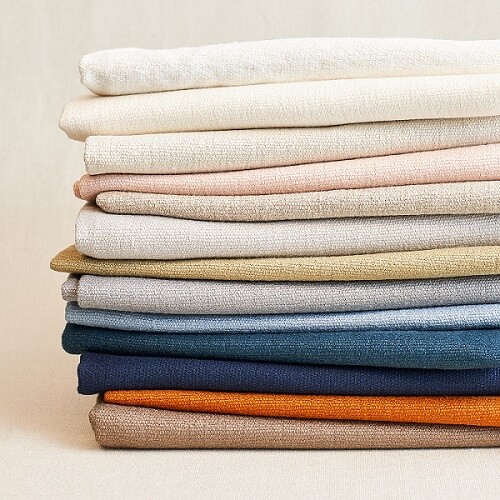Coated fabric: It is a kind of fabric treated by special technology. It can…
Fabric Grams, Textile Ounces, the Issues that Need Attention in the Purchasing Process
Table of Contents
Related Term
Fabric Grams: The weight of fabric per square meter in g/m².
Textile Ounces: the number of ounces per square yard, in oz/y².
Fabric Thickness: the distance between the front and back surface of the fabric, commonly units are mm, y, inch.
The relationship between grams, textile ounces, and thickness
Grams and textile ounces are the key parameters to express the heaviness of the fabric, while thickness is not generally used as a professional parameter. For knitted fabric, extends in all directions and has large elasticity, so there is the concept of “unfilled coefficient”, which is the size of the pore area. So for the same thickness of fabric, the larger the pore area, the smaller the grams, otherwise the larger.

Different fabrics, due to the different elasticity and extension, when measuring the thickness, the same clamping method produces different deformation of the fabric, and the resulting error will be different. Therefore, the thickness of the fabric don’t as a professional parameter generally, while the grams or textile ounces as an important parameter of the fabric’s heaviness.
For different countries and regions, because the habits of expressing weight and length are different, such as expressing length in meters, yards, etc., and expressing weight in grams, ounces, etc. Therefore grams and textile ounces are different customary expressions for the fabric weight of the unit area.
Fabric weight, textile ounce, the issues that need attention in the purchasing process
Confirm that the parameters are correctly understood
For example, a customer is looking for a fabric, he has certain requirements for the heaviness of the fabric, so he told the fabric seller that he wanted 14 ounces to 15 ounces of fabric. The seller sent him a material, after all, such a thick fabric, not the mainstream of the market, and there is not much room for choice, a meter-long fabric is close to a kilogram. Later the customer responded that it was too thick, and he wanted a thinner fabric. After deeper understanding, I realized that he wanted about 12oz, not 14-15oz.
Why would there be such a large error in the value? If it is because of such an error to send the version abroad, not only a waste of money, but also time-consuming, and may even cause the loss of customers, it is very important to figure out the real needs of the customer in advance. Here I will analyze the problem in detail.
Internationally, there exist two kinds of expressions for fabric heaviness, grams, and ounces. In the process of fabric purchasing, both buyers and sellers usually ignore the unit area and directly talk about how many grams and how many ounces, such as 300g, 13oz. When we say how many grams of fabric, its unit area is 1m²; when we say how many ounces, its unit area is 1y².
One is g/m²; the other one is oz/y². The conversion relationship between them is as follows.
1y = 0.9144m, 1oz = 28.375g
Then, 1oz/y² = 28.375g / (0.9144m*0.9144m) = 33.936g/m²
Note: Ounces here refer to textile ounces, not oz.av, 1oz.av = 28.350g, be careful to distinguish.
Review the previous example of why the customer produced a relatively large numerical error? It turns out that the customer got the data about 410g/m², and then it is divided directly by 28.375 to the ounce value is 14.449oz, but this value is the number of ounces in a square meter, not the number of ounces in a square yard. The correct algorithm should be: 410 / 33.936 = 12.08
Metric units are unified or imperial units are unified to facilitate communication and accurate understanding of the customer’s true needs.
Conduct testing to confirm whether the parameters meet the requirements
For the grams or ounce parameters provided by the fabric seller, we need to learn to test to confirm, so as to avoid unnecessary trouble, the cost of prior gate-keeping is far less than the cost of remedy afterward. So, how is this data derived from it? Here to use two instruments, fabric scale, and sampling cutter.

First, use the sample cutter to cut out a circular fabric with an area of 100cm², or use a ruler and scissors to cut a square fabric of 10cm*10cm by yourself. Then use the fabric scale to weigh the sample, which is the weight of the fabric of 100cm², but the common unit is g/m², so you have to multiply it by 100 to get the grams of the fabric.
For example, when buying fabric, if the number of grams provided by the merchant is: 330g/m², then the result of weighing the 100cm² of fabric we cut should be about 3.30g. In addition, the error should not be too big, the deviation up and down is generally about 20g/m², or the customer has requirements, follow the request.

How to calculate the real price and actual length of the fabric

In the actual buying and selling process, there are inevitably cases where the fabric is underweight and the length is not accurate. Thus, it is difficult for us to budget our actual cost. By calculating the real price and actual length of the fabric, we can use it as one of the bases for choosing our suppliers. The specific calculation method is as follows.

Select a roll of fabric randomly, weigh the entire weight, recorded as W1, record its width as M and grams. Spread out on the cutting bed and after initial cutting, if there is a paper tube, weigh the paper tube as W2 and calculate W1-W2, if there is no paper tube, W2 = 0.
Then
Actual weight of the fabric: W = W1-W2
Actual length of the fabric: L = (W1-W2) / (grams*M)
There are two general ways of pricing in the fabric market: by weight and by length. We should combine the needs of designers and actual production, choose the right width of fabric, and then compare the actual weight and actual length of each fabric seller, so as to make our purchase more convincing.




This Post Has 0 Comments